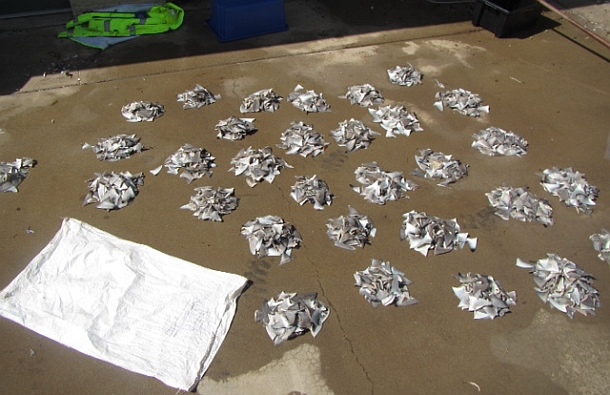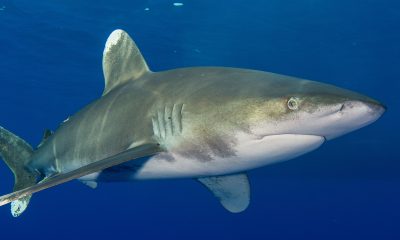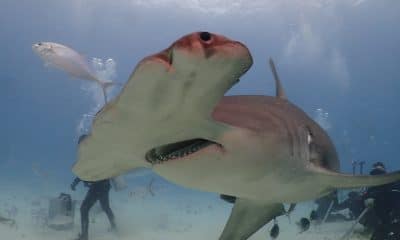News
How involved is Australia in the Global Shark Fin Trade?

Marine conservationists have renewed calls for an outright ban on shark fins in Australia.
Earlier this month a Queensland recreational fisherman was fined $7,750 after being caught with 3,206 shark fins suspected of being destined for the black market.
It is believed to be Australia’s largest ever haul of illegal shark fins.
The Australian Marine Conservation Society (AMCS) says it’s time for Australia to end its involvement in the international shark fin trade and is also calling for tougher penalties for those who illegally harvest shark fins in the country.
AMCS marine campaigner Tooni Mahto says current penalties don’t serve as a deterrent because shark fins have such a high value.
‘So the incentive is still out there for others to do the same,’ she says.
‘Shark fin soup is available on pretty much any Chinese restaurant menu. It may not be advertised on menus but the availability of shark fin soup is still there in restaurants.
‘If you go to Chinatown in Sydney and Melbourne you can see the very big shark fins with a $1,000 price tag, and you can also buy jars of smaller, cheaper shark fins for up to $700 to $800.’
The high price tag reflects the cultural value of shark fins, which have traditionally been served by the Chinese at special functions to show the wealth of the host and respect for their guests.
As the Chinese middle class has expanded, so has the demand for shark fins which has grown around 5 per cent a year since the mid-‘90s.
The International Union for the Conservation of Nature (IUCN) has determined that approximately a third of open ocean sharks are currently threatened with extinction.
Mahto says the international shark fin trade is responsible for the decline in many shark populations, especially species with large fins such as great whites and whale sharks.
‘It can be traced directly back to the shark fin trade,’ she says.
The Queensland fisherman’s crime and subsequent conviction has raised questions about the extent of illegal shark fishing in Australia. He was one of three fisherman arrested after a raid on their Maryborough fishing shack in April last year after a public tip-off about illegal mud crabs.
Queensland Boating and Fisheries Patrol district manager Greg Bowness says the discovery of so many shark fins surprised the authorities but believes it’s an unusual case and doesn’t point to a bigger problem – but Mahto isn’t convinced.
“My feeling is that it suggests there is more activity going on that we simply don’t know about,” she says.
In the Maryborough case, authorities could not determine whether the shark fins were to be sold locally or on the overseas market, nor how the shark fins were harvested.
Live shark finning, the practice of cutting fins from live sharks and dumping their bodies, is illegal in all jurisdictions in Australia, but marine conservationists have accused Australia of being complicit in the cruel trade by allowing imports of shark fins that cannot be traced to their source.
Data for shark fin imports to Australia has only been available for the past couple of years. Australia imported 23 tonnes in 2013 and 18 tonnes in 2014.
Mahto says it’s highly likely those imports include fins harvested from live sharks.
“Shark fin can be traded from one port to another before it is imported to Australia so it’s really hard to know if we’re importing shark fin from countries like India and Indonesia that still allow live shark finning,” she says.
“If we’re importing shark fins from such countries then we’re still supporting that practice, albeit not around our own shores.”
NSW Greens MP Mehreen Faruqi believes most shark fin imports to Australia are harvested from live sharks.
Last month Faruqi introduced a private members bill into the NSW Parliament seeking to amend the Food Act to make it an offence to possess, sell, prepare or process shark fins or any shark fin derivative.
“It would basically ban any shark fin soup being served in restaurants,” says Faruqi.
The Greens MP says there is strong community support for such a ban, but the numbers in parliament are uncertain.
“There are discussions going on about when the bill might be debated and how much support we might have, so we’re building on that and hopefully the government will come on board with majority community opinion.”
Her ultimate aim is an Australia-wide ban on shark fin imports.
“NSW can lead this action by showing that something can be done at a state level. Other states can follow, and hopefully we can push the Australian government to look into the ban of the possession, sale, and trade of shark fin in Australia,” she says.
As well as importing shark fins, Australia also exports them. Between 2011 and 2012 Australia exported 178 tonnes, but in recent years the export market has declined.
In 2013 there were no shark fin exports, and in 2014 just one tonne was exported.
The AMCS doesn’t believe the drop in exports means fewer sharks are being killed in Australian waters. The organisation suspects fins are being stockpiled until prices improve.
The recent drop in demand for shark fins is being attributed to effective public campaigns and a corruption crackdown in China.
“It does look like there has been some impact from public education campaigns using high profile figures like Hollywood actors and Chinese celebrities to change people’s behaviour,” says Mahto.
“But the Chinese government also has a big anti-corruption drive. Shark fin has been banned from being served at public political events and that seems to have had a real impact on the price of shark fins and as a knock-on effect the international trade.”
The AMCS has a long running campaign for an outright ban on shark fins in Australia. Mahto says such a ban would provide absolute certainty that Australia is not importing shark fins from countries that still allow live finning.
“That’s an important conservation outcome,” she says, “but it’s also a very public statement that Australia does not support the inhumane trade and it’s recognition that the value of sharks is in keeping ecosystems healthy rather than being served up as soup.”
Source: www.marineconservation.org.au
Gear News
Scubapro Free Octopus Promotion 2024

Free Octopus with every purchase of a SCUBAPRO regulator system
Just in time for the spring season, divers can save money with the FREE OCTOPUS SPRING PROMOTION! Until July 31st SCUBAPRO offers an Octopus for free
with every purchase of a regulator system!
Get a free S270 OCTOPUS with purchase of these combinations:
MK25 EVO or MK19 EVO with A700
MK25 EVO or MK19 EVO with S620Ti
MK25 EVO or MK19 EVO with D420
MK25 EVO Din mit S620Ti-X
Get a free R105 OCTOPUS with purchase of the following combinations:
MK25 EVO or MK19 EVO with G260
MK25 EVO or MK17 EVO with S600
SCUBAPRO offers a 30-year first owner warranty on all regulators, with a revision period of two years or 100 dives. All SCUBAPRO regulators are of course certified according to the new European test standard EN250-2014.
Available at participating SCUBAPRO dealers. Promotion may not be available in all regions. Find an authorized SCUBAPRO Dealer at scubapro.com.
More information available on www.scubapro.com.
Blogs
Northern Red Sea Reefs and Wrecks Trip Report, Part 3: The Mighty Thistlegorm

Jake Davies boards Ghazala Explorer for an unforgettable Red Sea diving experience…
Overnight, the wind picked up, making the planned morning dive a bit bumpy on the Zodiacs to the drop point on Thomas Reef. There, we would dive along the reef before descending through the canyon and then passing under the arch before ascending the wall with a gentle drift. The site provided great encounters with more pelagic species, including shoals of large barracuda, tuna, and bigeye trevally.
Once back on the boat, it was time to get everything tied down again as we would head back south. This time, with the wind behind us, heading to Ras Mohammed to dive Jackfish Alley for another great gentle drift wall dive before then heading up the coast towards the Gulf of Suez to moor up at the wreck of the Thistlegorm. This being the highlight wreck dive of the trip and for many onboard, including myself, it was the first time diving this iconic wreck. I had heard so much about the wreck from friends, and globally, this is a must on any diver’s list. Fortunately for us, there was only one other boat at the site, which was a rarity. A great briefing was delivered by Ahmed, who provided a detailed background about the wreck’s history along with all the required safety information as the currents and visibility at the site can be variable.

Kitting up, there was a lot of excitement on deck before entering the water and heading down the shoreline. Descending to the wreck, there was a light northerly current which reduced the visibility, making it feel more like the conditions that can be found off the Welsh coast. At 10m from the bottom, the outline of the wreck appeared as we reached the area of the wreck which had been bombed, as our mooring line was attached to part of the propeller shaft. Arriving on deck, instantly everywhere you looked there were many of the supplies which the ship was carrying, including Bren Carrier tanks and projectiles that instantly stood out.

We headed around the exterior, taking a look at the large propeller and guns mounted on deck before entering the wreck on the port side to take a look in the holds. It was incredible to see all the trucks, Norton 16H, and BSA motorcycles still perfectly stacked within, providing a real snapshot in time.

Overall, we had four dives on the Thistlegorm, where for all of the dives we were the only group in the water, and at times, there were just three of us on the whole wreck, which made it even more special, especially knowing that most days the wreck has hundreds of divers. Along with the history of the wreck, there was plenty of marine life on the wreck and around, from big green turtles to batfish, along with shoals of mackerel being hunted by trevally. Some unforgettable dives.

The final leg of the trip saw us cross back over the Suez Canal to the Gobal Islands where we planned to stay the night and do three dives at the Dolphin House for the potential of sharing the dive with dolphins. The site, which included a channel that was teeming with reef fish, especially large numbers of goatfish that swam in large shoals along the edge of the reef. These were nice relaxing dives to end the week. Unfortunately, the dolphins didn’t show up, which was okay as like all marine life they are difficult to predict and you can’t guarantee what’s going to be seen. With the last dive complete, we headed back to port for the final night where it was time to clean all the kit and pack before the departure flight the next day.

The whole week from start to finish on Ghazala Explorer was amazing; the boat had all the facilities you need for a comfortable week aboard. The crew were always there to help throughout the day and the chefs providing top quality food which was required after every dive. The itinerary providing some of the best diving with a nice mixture of wreck and reef dives. I would recommend the trip to anyone, whether it’s your first Red Sea liveaboard in the Red Sea or you’re revisiting. Hopefully, it’s not too long before I head back to explore more of the Red Sea onboard Ghazala Explorer.

To find out more about the Northern Red Sea reef and wrecks itineraries aboard Ghazala Explorer, or to book, contact Scuba Travel now:
Email: dive@scubatravel.com
Tel: +44 (0)1483 411590
Photos: Jake Davies / Avalon.Red
-

 News3 months ago
News3 months agoHone your underwater photography skills with Alphamarine Photography at Red Sea Diving Safari in March
-

 News3 months ago
News3 months agoCapturing Critters in Lembeh Underwater Photography Workshop 2024: Event Roundup
-

 Marine Life & Conservation Blogs2 months ago
Marine Life & Conservation Blogs2 months agoCreature Feature: Swell Sharks
-

 Blogs2 months ago
Blogs2 months agoMurex Resorts: Passport to Paradise!
-

 Blogs2 months ago
Blogs2 months agoDiver Discovering Whale Skeletons Beneath Ice Judged World’s Best Underwater Photograph
-

 Gear Reviews3 months ago
Gear Reviews3 months agoGear Review: Oceanic+ Dive Housing for iPhone
-

 Marine Life & Conservation2 months ago
Marine Life & Conservation2 months agoSave the Manatee Club launches brand new webcams at Silver Springs State Park, Florida
-

 Gear Reviews2 weeks ago
Gear Reviews2 weeks agoGEAR REVIEW – Revolutionising Diving Comfort: The Sharkskin T2 Chillproof Suit














